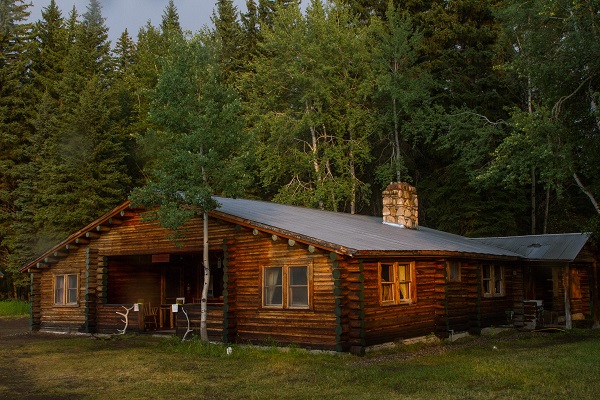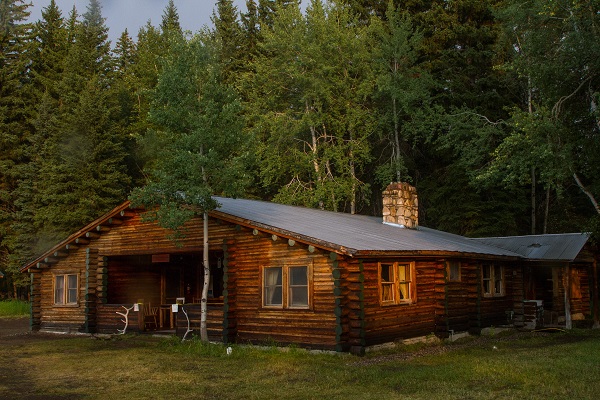
Ever since the Muries purchased the old STS Dude Ranch in 1945, this homestead-era dwelling has found a special place in history. The property is known for its quietness, serenity and open appeal to all who venture here. This National Park Service land is unfenced, allowing flora and fauna to flourish alongside their visiting human counterparts. As much as it is a natural place of beauty, the Murie Ranch is also steeped in legacy, holding the coveted distinction of a National Historic Landmark.
 Let’s look back to the Murie beginning, as partnering owners: Olaus, Mardy, Adolph, and Louise all shared their energy to establish this private in-holding as a unique place. One of their first tasks as owners was to take down the ranch fences. It would no longer operate as a dude ranch. You could say they wanted their land to be naturally wild. It was a purposeful decision they made, not only in reverence of nature but also to role model their beliefs regarding the ideas of parks more broadly.
Let’s look back to the Murie beginning, as partnering owners: Olaus, Mardy, Adolph, and Louise all shared their energy to establish this private in-holding as a unique place. One of their first tasks as owners was to take down the ranch fences. It would no longer operate as a dude ranch. You could say they wanted their land to be naturally wild. It was a purposeful decision they made, not only in reverence of nature but also to role model their beliefs regarding the ideas of parks more broadly.
The Muries believed without question that National Parks should not have fences. Speaking on behalf of wildlife diversity, the Muries felt that all species should be able to move unrestricted to access necessary food and water. All animals, in other words, should be given natural freedoms.
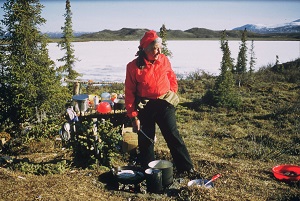 Not everyone in Jackson Hole agreed. And Olaus knew this. With his great understanding of science, along with his willingness to discuss these important ideas, he saw many turbulent issues to successful conclusions.
Not everyone in Jackson Hole agreed. And Olaus knew this. With his great understanding of science, along with his willingness to discuss these important ideas, he saw many turbulent issues to successful conclusions.
When Olaus passed in October of 1963, Mardy naturally began to grieve. They had shared 39 beautiful years of marriage For Mardy, it took about three years for her to navigate through her sorrow and loss. She actually left the ranch for about two years, though eventually she returned, her spirit renewed. She dedicated the rest of her life to seeing the dream she shared with Olaus come true. That dream was to preserve more of Alaska.
 In 1960, the Muries helped save the first 8 million acres of the Arctic National Wildlife Refuge through their study in the northeast region of Alaska’s Brooks Range. With that success, and with the passing of the Wilderness Act in September of 1964, Mardy firmly put her conservationist hat back on to continue saving wild places.
In 1960, the Muries helped save the first 8 million acres of the Arctic National Wildlife Refuge through their study in the northeast region of Alaska’s Brooks Range. With that success, and with the passing of the Wilderness Act in September of 1964, Mardy firmly put her conservationist hat back on to continue saving wild places.
To accomplish anything worthwhile in life requires focus, dedication, and a steadfast belief that your mission is the right path forward. At that particular moment in Mardy’s life, she was undergoing a resolute transformation. She was becoming a Super Nova Grandma, a well informed, articulate, impassioned senior citizen capable of helping America realize how important it was to save the natural wildness of Alaska.
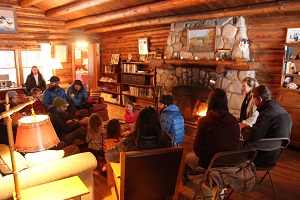 By then, Mardy had authored her first book: Two in the Far North, a notable chronicle of her beloved Alaska and life studies with Olaus. While the book is certainly a love story, it is also much more, a compelling narrative that leaves readers fairly enchanted. This book inspires folks to come see the Murie Ranch on a pilgrimage.
By then, Mardy had authored her first book: Two in the Far North, a notable chronicle of her beloved Alaska and life studies with Olaus. While the book is certainly a love story, it is also much more, a compelling narrative that leaves readers fairly enchanted. This book inspires folks to come see the Murie Ranch on a pilgrimage.
Here are some lesser-known facts about this Grandmother of American Conservation: She was humble as the day is long. If you came to visit Mardy, she would turn her focus on you, probably not tell you about her accomplishments, but instead as an amazing host for you and all her visitors. Through her golden years, Mardy adopted similar skills to those that Olaus had. Forever the diplomat, she carefully navigated countless concerns, conflicts, and battles without condemning, belittling or arguing with opponents. She was able to disagree without offending the other guy.
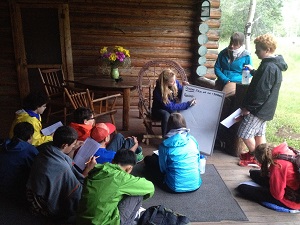 That is a remarkable trait that most humans never master. Mardy became a center of influence, basing her life on her unwavering respect, support and admiration for the majesty of our natural world. She was an amazing role model, forever encouraging us all to be the best at who we are, the best at what we choose to do. As we study the Muries, we can learn something quite profound: human understanding and kindness go a long way. We also learn that we can accomplish much by focusing on the most important thing. Lastly, we can answer one key question: can one person make a difference in life? The enthusiastic answer, the Muries show us, is an overwhelming YES!
That is a remarkable trait that most humans never master. Mardy became a center of influence, basing her life on her unwavering respect, support and admiration for the majesty of our natural world. She was an amazing role model, forever encouraging us all to be the best at who we are, the best at what we choose to do. As we study the Muries, we can learn something quite profound: human understanding and kindness go a long way. We also learn that we can accomplish much by focusing on the most important thing. Lastly, we can answer one key question: can one person make a difference in life? The enthusiastic answer, the Muries show us, is an overwhelming YES!

